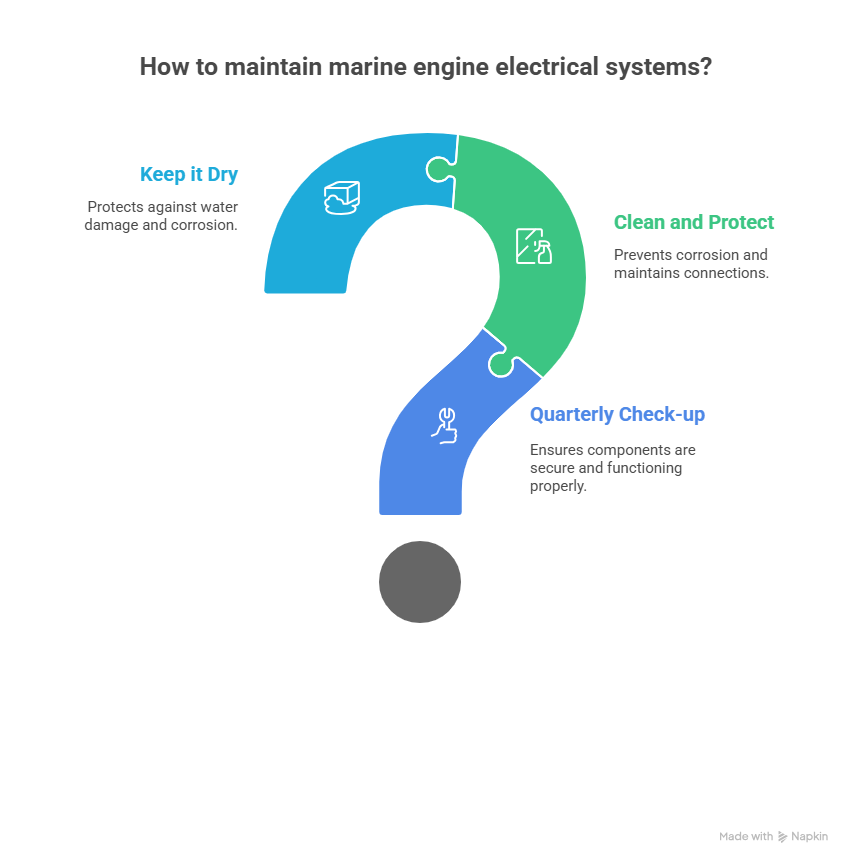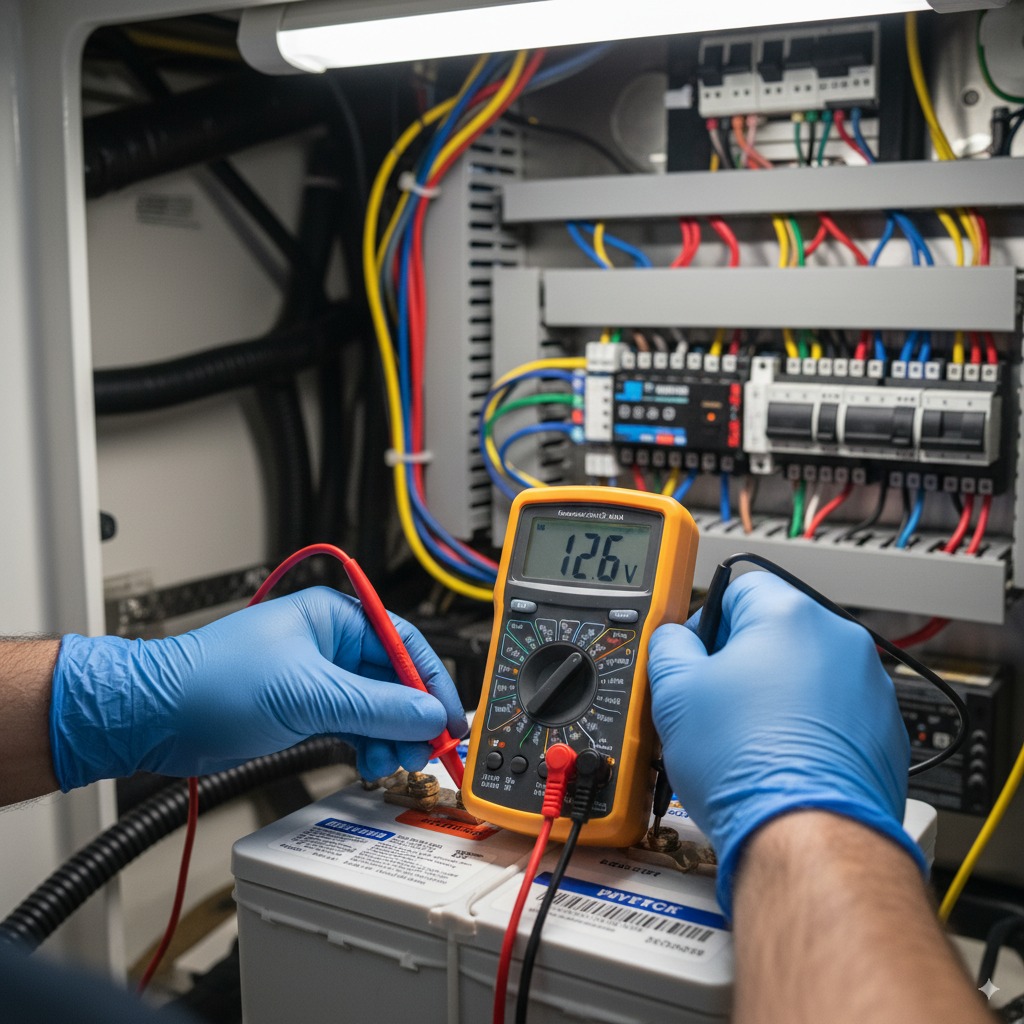I can’t tell you how many beautiful days on the water I’ve seen ruined by a simple electrical gremlin. You’re miles out, the sun is perfect, and then… click. Nothing. That dead silence when you turn the key is a feeling every boater dreads. Nine times out of ten, the engine is fine—it’s the electrical systems in marine engines that have given up the ghost.
Last summer, a guy named Dave brought his 28-foot center console to my shop at Dinner Key Marina. His fishfinder was flickering, his engine was slow to crank, and he was convinced he needed a new motor. He was ready to spend thousands. I took one look and went straight to his battery terminals. They were fuzzy green with corrosion. I spent 20 minutes cleaning them, tightened the ground wire on the engine block, and the boat fired up like it was brand new. He couldn’t believe it.
That’s the thing about the electrical systems in marine engines: they’re the unsung heroes and the silent killers. They don’t get the glory of a roaring V8, but when they fail, everything stops.
This guide is my brain dump of 15 years of chasing volts and amps around boats in South Florida. I’m going to break down the complex stuff into plain English, show you how to find problems, and teach you how to keep those electrical gremlins away for good.
Table of Contents
The Big Three: What Powers Your Engine
Think of your boat’s electrical system like your own body. You’ve got the heart, the muscles, and the brain. In your engine, it’s the battery, the starter, and the alternator. These are the core of the electrical systems in marine engines.
- The Battery (The Heart): This is where all the power lives when the engine is off. It’s the juice that gets everything started.
- The Starter (The Muscle): This is a powerful little motor that does the heavy lifting, cranking your big engine over until it can run on its own.
- The Alternator (The Brain & Power Plant): Once the engine is running, the alternator takes over. It generates all the electricity needed to run your boat and, just as importantly, it recharges your battery.
Of course, you’ve got wires (the nerves), fuses (the safety net), and regulators (the traffic cops), but if you understand how the “Big Three” work together, you’re halfway to understanding all electrical systems in marine engines.
Common Gremlins and Where They Hide
In the marine world, electricity has two mortal enemies: saltwater and vibration. They are relentless. Here are the problems I see over and over again.
The Silent Killer: Corrosion
Corrosion is the cancer of boat wiring. That salty, humid air gets into every connection and starts eating away at the metal, creating resistance. Resistance is like a clog in a pipe—power can’t get through. It causes flickering lights, weak starts, and all sorts of weird, intermittent problems. I always check the battery terminals and the main engine ground first. That’s where the gremlins love to build their nests.
Battery Blues
A dead battery is the #1 reason for a no-start. But sometimes the battery isn’t the real problem. If you hear a “click” but no crank, it could be the battery is too weak to turn the starter, or the power isn’t getting from the battery to the starter because of—you guessed it—corrosion. A healthy, fully charged battery should read 12.5–12.7 volts on a multimeter. Anything below 12V is a red flag.

Charging System Failures
If your alternator isn’t doing its job, your battery will slowly die while you’re running. You might not even notice until you try to restart the engine. With the engine running, you should see 13.8–15.3 volts at your battery. If you see battery voltage (or less), your alternator is on vacation. Understanding the charging side of electrical systems in marine engines is crucial.
Troubleshooting 101: Playing Detective with a Multimeter
Your multimeter is the most important tool you can own for electrical work. It lets you see electricity. It turns you into a detective. When I start troubleshooting, I follow a simple process.
| My Troubleshooting Checklist | What I’m Looking For | What It Tells Me |
|---|---|---|
| Visual Inspection | Fuzzy corrosion, loose wires, burnt smells | The obvious stuff. You’d be surprised how often the problem is right in front of you. |
| Battery Voltage (Engine Off) | 12.5V or higher | Is the heart of the system even healthy? |
| Battery Voltage (Engine On) | 13.8V or higher | Is the alternator doing its job and recharging the battery? |
| Continuity Test | A “beep” from the multimeter | Is this wire broken somewhere inside its insulation? |
| Voltage Drop Test | Less than 0.5V across a connection | Is a corroded connection acting like a bottleneck, restricting power flow? |
This systematic approach is key to diagnosing electrical systems in marine engines without just throwing parts at the problem.
Keeping the Gremlins Away: Proactive Maintenance
The best way to fix an electrical problem is to make sure it never happens. A little bit of prevention goes a long way.
- Quarterly Check-up: Every three months, I do a walk-through. I physically check that the battery terminals are tight. I look at the main ground on the engine block. I inspect the alternator belt.
- Clean and Protect: Once a year, I disconnect my battery terminals and clean them with a wire brush until they are shiny. Then I spray them with a marine-grade corrosion inhibitor. This one step prevents so many headaches.
- Keep it Dry: Water and electricity don’t mix. Make sure your batteries are in a dry, ventilated box. Keep your bilge dry to protect wiring that runs through it.
This simple routine is the most effective way to maintain the health of all electrical systems in marine engines.
FAQ: Quick Answers from the Shop
Why is marine wire so expensive?
Because it’s tinned. Each little copper strand is coated in tin to resist corrosion. Using cheap automotive wire on a boat is one of the worst mistakes you can make. It will turn to green dust in a couple of years.
My battery is a year old and it’s dead. Why?
It was likely either a bad battery from the start, you have a parasitic draw (something is draining it when the boat is off), or your alternator isn’t charging it properly.
What’s that single “click” noise when I try to start?
That’s usually the starter solenoid engaging but not having enough power to turn the starter motor. It can be a weak battery, a bad connection, or a failing solenoid.
Can I jump-start my boat like a car?
Yes, but be careful. Make sure you connect positive to positive and negative to negative, and make sure the boat you’re jumping from has a comparable or larger battery. A mistake can fry sensitive electronics.
Is it safe to do my own electrical work?
Basic stuff, yes. Cleaning terminals, changing a battery, replacing a fuse—go for it. But if you’re not 100% confident, especially with anything involving AC power or complex wiring, call a professional. A mistake with the electrical systems in marine engines can cause a fire.
The Bottom Line: My Final Advice
Look, when it comes to the electrical systems in marine engines, it’s not black magic. It’s just logic. If you take away anything from this, let it be these points:
- Corrosion is Your #1 Enemy. Be relentless. Clean and protect all your connections.
- Your Multimeter is Your Best Friend. Learn to use it. It will tell you secrets your engine can’t.
- Voltage is Your Health Report. Know your numbers. 12.6V engine off, 14.4V engine on. These are your vital signs.
- Prevention is Cheaper Than a Tow. A little bit of maintenance will save you from a lot of frustration and expense.
- Know When to Call for Backup. Don’t be a hero. If you’re in over your head, a good marine electrician is worth every penny.
Take care of the electrical systems in marine engines, and they’ll take care of you. It’s that simple. Now go check your battery terminals!
Author Bio
I’m Alex, a 15-year marine technician in South Florida and an ABYC-certified expert in electrical systems in marine engines. From diagnosing phantom drains on sportfishers at Bahia Mar to rewiring entire vessels at Dinner Key, I’ve spent my career keeping boats powered up and reliable in the harshest saltwater environment.


Leave a Reply